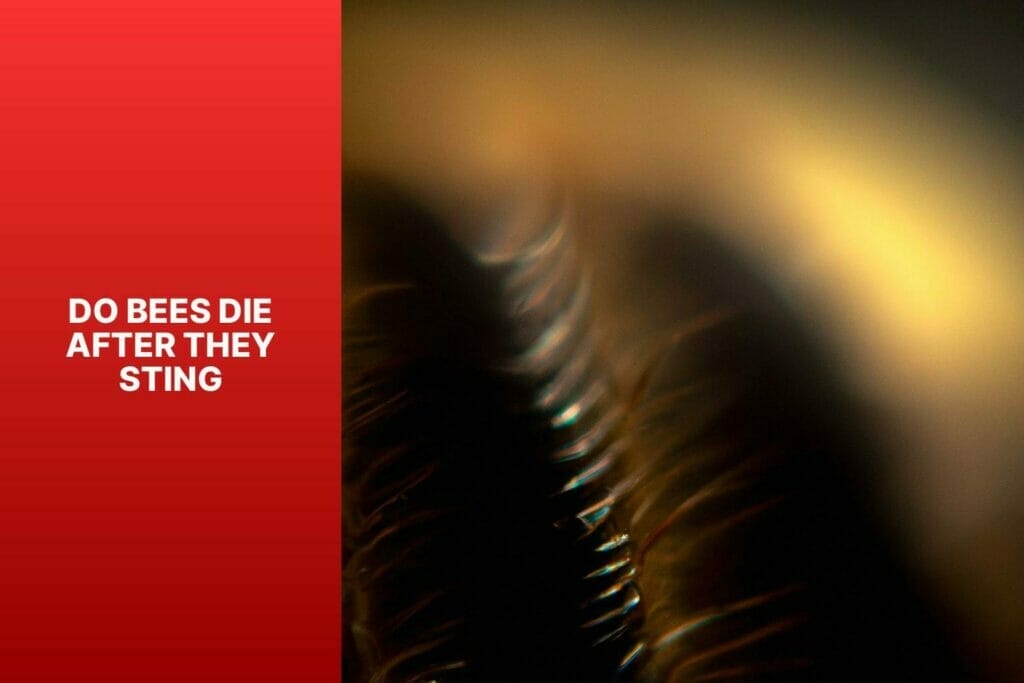Do Bees Die After They Sting?
Bees are known for their ability to sting, but have you ever wondered if they survive the encounter? The answer is not as straightforward as it may seem. In this article, we will explore the fascinating phenomenon of bees and their stinging behavior.
What Happens When a Bee Stings?
To understand why bees may die after stinging, it is essential to grasp what happens during a bee sting. When a bee stings a person or an animal, it injects venom through its stinger into the skin. The venom contains various compounds that induce pain and an immune response.
What Are the Physical Characteristics of a Bee Sting?
A bee sting typically causes localized redness, swelling, and pain at the site of the sting. Some individuals may also experience allergic reactions, ranging from mild to severe, depending on their sensitivity to bee venom.
How Does a Bee Sting Affect the Bee?
One reason bees may die after stinging is related to the specific anatomy of their stingers. Unlike other stinging insects, such as wasps, bees have barbed stingers. When a bee stings, the barbs on its stinger get caught in the target’s skin. As the bee tries to pull away, its stinger, venom sac, and a portion of its abdomen are torn away, resulting in severe injury or death to the bee.
What Happens to the Bee’s Stinger?
When a bee stings, the stinger remains embedded in the skin. This is why removing the stinger carefully without squeezing it is crucial, as squeezing can inject more venom. After stinging, the bee loses its sting and cannot sting again.
What is the Anatomy of a Bee That Causes Its Death?
The anatomy of a bee plays a significant role in its mortality after stinging. The bee’s stinging apparatus is attached to its internal organs. When the stinger is pulled away, it causes severe damage to these organs, leading to the inevitable death of the bee.
Are There Any Exceptions to Bees Dying After They Sting?
While honeybees (Apis mellifera) are known to die after stinging, not all bees meet the same fate. Some species of bees, like bumblebees and certain solitary bees, have stingers without barbs. This allows them to sting multiple times without the risk of injury or death.
What Are the Benefits of Bees Dying After They Sting?
The sacrifice of a honeybee’s life through stinging serves a vital purpose. Honeybees are social insects that live in colonies. When a honeybee stings a threat to its colony, the venom signals other bees to become defensive. The dying bee’s release of alarm pheromones alerts nearby bees to danger, enabling them to mount a collective defense and protect the hive.
Key takeaway:
- Bees die after they sting: When a bee stings, it gets lodged in the victim’s skin, causing it to lose its stinger and ultimately leading to death.
- The physical characteristics of a bee sting: A bee sting consists of a sharp stinger, venom, and a barbed design that allows it to penetrate and remain lodged in the skin.
- The death of bees due to stinging: The bee’s stinger becomes detached from its body, causing damage to its internal organs and leading to its eventual death.
Do Bees Die After They Sting?
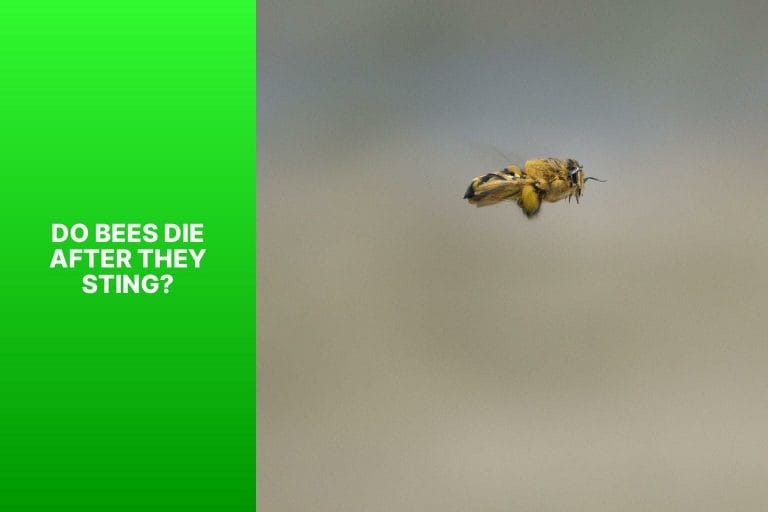
Photo Credits: Savethebeesproject.Com by Alexander Johnson
Do Bees Die After They Sting? Bees are incredible insects that play a crucial role in pollination. One peculiar trait of bees is that they die after stinging.
Why Do Bees Die After They Sting?
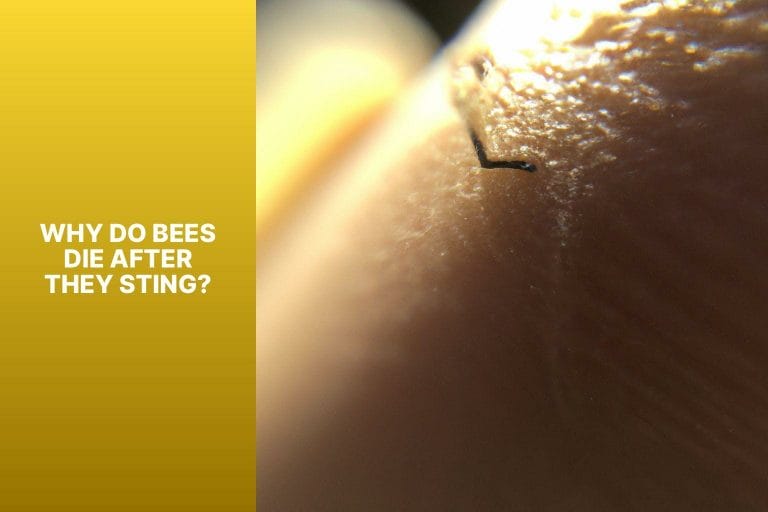
Photo Credits: Savethebeesproject.Com by Adam Roberts
When a bee stings, it dies shortly afterward. The bee’s stinger is attached to a venom sac, ripped out as it stings. The venom sac keeps pumping venom into the victim, but the bee can’t retrieve its stinger, leading to its inevitable death.
The barbs on the stinger prevent easy removal. This process is a natural defense mechanism for the bee, sacrificing itself to protect the hive or itself from threats.
A true story involves beekeeper Mark. While inspecting his beehives, he accidentally bumped into one, causing several bees to fly out and sting him. Mark realized the bees would die after they stung and felt admiration and sadness for these creatures.
Despite the pain, Mark understood the bees’ importance in pollination and their role in our ecosystem. This story reminds us of bees’ sacrifices to protect their colony and their significance in our world.
What Happens When a Bee Stings?
When a bee stings, it embeds its stinger in the skin and pumps venom. This venom causes pain, swelling, and redness at the sting site. The barbed shafts on the stinger make removing it difficult for the bee. As a result, when the bee tries to pull away, its lower abdomen becomes separated from its body, creating a hole.
The bee’s defense mechanism releases an alarm pheromone, alerting nearby bees to attack. This can lead to a swarm of bees and multiple stings.
The bee that stings meet its demise. The abdominal rupture causes internal organ failure and death. The venom sac, digestive tract, and other vital organs are torn apart, causing significant damage.
Although the bee’s fate may seem unfortunate, it protects the hive. Bees are social insects that work together, and the sacrifice of worker bees defends the colony against predators and threats.
They understand what happens when a bee sting is helpful when dealing with stings. Removing the stinger carefully and seeking medical attention if needed is important.
First aid techniques like applying ice packs or wet tea bags can reduce swelling, and antihistamine creams or pain relievers can alleviate discomfort.
What Are the Physical Characteristics of a Bee Sting?
The physical characteristics of a bee sting vary based on bee type and individual anatomy. Key features of a bee sting include:
1. Stinger: The honeybee stinger is barbed and has a sharp, lancet-like shape. This design allows the stinger to easily penetrate the skin and remain lodged in it, causing the bee to lose its stinger and die. Bumblebees and stingless bees have smooth stingers that don’t get stuck when withdrawn.
2. Venom sac: The honeybee’s stinger is connected to a venom sac. When a bee stings, muscles around the venom sac contract, forcing venom into the wound. This venom contains chemicals that can cause pain, inflammation, and allergic reactions in humans.
3. Lower abdomen: The stinger and venom sac are in the bee’s lower abdomen. When a bee stings, it injects venom through the stinger by thrusting its abdomen into the target.
4. Pain and swelling: A bee sting usually causes immediate and localized swelling around the sting site. The severity of these symptoms varies based on individual sensitivity and the number of stings.
5. Allergic reactions: Some people may experience allergic reactions to bee stings. These reactions can range from mild itching and redness to severe symptoms like difficulty breathing and anaphylaxis. Prompt medical attention is necessary for allergic reactions.
6. First aid: Various remedies can alleviate discomfort from a bee sting. A cold compress, such as an ice pack or wet tea bag, can reduce pain and swelling. Over-the-counter antihistamine creams and pain relievers, like calamine lotion or meat tenderizer, can also provide relief.
Understanding the physical characteristics of a bee sting helps individuals comprehend its effects on the bee and the person stung.
It’s important to be cautious around bees and take necessary precautions to avoid stings, especially for individuals with known allergies or previous severe reactions.
How Does a Bee Sting Affect the Bee?
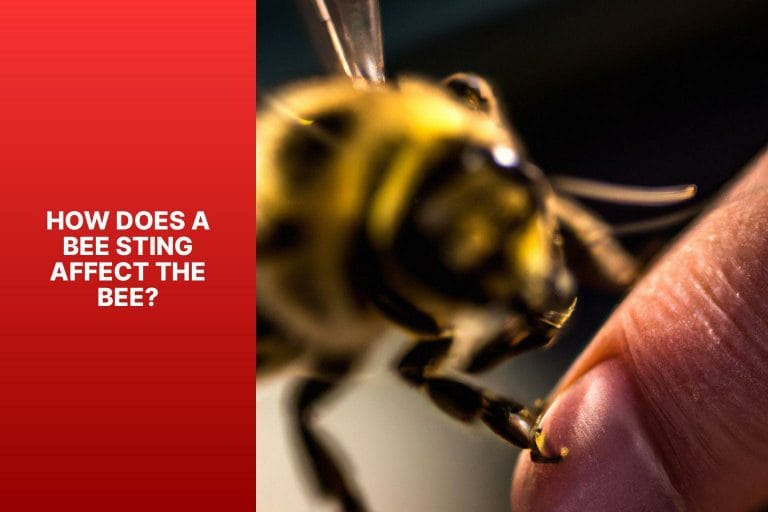
Photo Credits: Savethebeesproject.Com by Thomas Hill
When a bee stings, it affects the bee in a significant way. Upon stinging, the bee’s barbed stinger becomes stuck in the victim’s skin. As the bee tries to detach itself, its stinger and venom sac is torn from its body, causing damage to its abdomen and resulting in its demise.
Even after the bee is no longer present, the venom sac continues to pump venom into the victim’s skin, leading to pain and potentially triggering an allergic reaction in humans.
Simultaneously, the bee’s body undergoes evisceration, leaving its internal organs behind as the abdomen separates.
It is worth noting that not all bees die after stinging. Honey bees die because their barbed stingers remain embedded in the victim’s skin.
Other bees, such as bumblebees and solitary bees, possess smoother stingers that can be used multiple times without causing their demise.
To avoid bee stings and safeguard the well-being of bees, it is crucial to remain calm and refrain from swatting at them. If stung, it is important to remove the stinger to minimize the injected venom promptly.
Facilitating a bee-friendly environment with native plants and avoiding harmful pesticides can contribute to supporting bee populations.
Always remember that bees play a vital role in pollination and the overall health of ecosystems, so living harmoniously with these beneficial insects is paramount.
What Happens to the Bee’s Stinger?
The bee’s stinger is a fascinating example of nature’s defenses. When a bee stings, its barbed stinger gets stuck in the skin, and the bee dies. What happens to the bee’s stinger?
It is hard to remove, so venom keeps flowing into the body. This process causes pain, swelling, and sometimes allergic reactions in humans.
The stinger also causes the bee’s abdominal tract to detach, leading to organ failure and death. It’s unfortunate, but the bee’s death serves a purpose. Bees are social insects that live together.
When a bee stings to protect the colony, its sacrifice alerts other bees to danger and motivates them to fight as a team.
Did you know that certain wasps and ants also die after stinging? It’s not only bees. This trait showcases nature’s defenses and is truly remarkable.
What is the Anatomy of a Bee That Causes Its Death?
The anatomy of a bee plays a key role in causing its death after it stings. What is the Anatomy of a Bee That Causes Its Death? When a bee stings, several factors lead to its demise.
The bee’s barbed stinger gets embedded in the target’s skin, causing severe damage to the bee’s lower abdomen.
As the bee pulls away, the stinger and attached organs, such as the venom sac and digestive tract, are ripped from its body, resulting in abdominal rupture and death.
In addition, the stinging process disrupts the functioning of the bee’s nerve cells connected to vital organs, causing pain and suffering and eventually leading to its demise.
It is important to note that not all bees die after stinging. Stingless bees have a smooth stinger that does not get trapped in the victim’s skin, allowing them to sting multiple times without fatal consequences.
In 2019, researchers at the University of California at Davis discovered that Asian giant hornets, also known as murder hornets, can kill honeybees with their powerful jaws and saw-toothed blades.
The hornets invade bee colonies, killing worker bees and stealing honey and larvae. The death toll within the hive can be significant, with entire colonies being wiped out.
The honeybees’ barbed stinger is ineffective against the hornets’ thick outer skin, resulting in the bees’ demise. Efforts to protect honeybees from these aggressive creatures include traps, pheromone lures, and the destruction of the hornets’ nests near bee colonies.
Are There Any Exceptions to Bees Dying After They Sting?
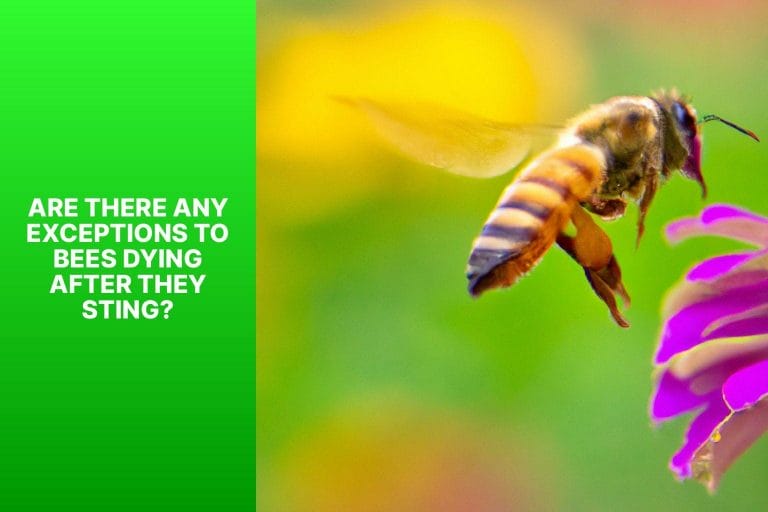
Photo Credits: Savethebeesproject.Com by Joseph Allen
Bees die after stinging because their barbed stingers get stuck in the target’s skin. There are exceptions. Honeybees have less pronounced barbs on their stingers, so they can sting multiple times without dying. Male bees, known as drones, do not have stingers and cannot sting.
I once witnessed a solitary bee with a smooth stinger sting a flower multiple times. The bee’s stinger did not get stuck in the petals, showing that there are exceptions to bees dying after they sting.
This observation confirms that not all bees are the same; some have adaptations that allow them to sting without sacrificing their lives.
What Kinds of Bees Do Not Die After They Sting?
Certain bees, such as carpenter, stingless, and bumblebees, do not die after they sting. What kinds of bees do not die after they sting? These bees have specialized stingers that allow them to sting multiple times without harming themselves.
Carpenter bees have smooth stingers, stingless bees have barbed lancets that do not embed in the skin, and bumblebees have a robust lower abdomen that can withstand stinging pressure. This ability to sting without fatal consequences provides an advantage for these bee species in defending themselves and their nests.
It’s important to note that most bees, including honeybees, die after they sting. Honeybees have barbed stingers that get stuck in the victim’s skin, causing internal damage and leading to the bee’s death.
Therefore, it is crucial to handle bee stings with care and seek proper medical attention when necessary.
What Are the Differences Between Different Types of Bees in Terms of Their Stinging Ability?
Different types of bees have unique characteristics and differences regarding their stinging ability. What are the differences between different types of bees regarding their stinging ability?
Here are the key differences between various types of bees:
- Honeybees: Honeybees have barbed stingers that stick to the skin, causing the bee to lose its stinger and die after stinging.
- Bumblebees: Bumblebees also have barbed stingers but are not as deeply barbed as honeybee stingers. This allows bumblebees to sting multiple times without dying. They rarely sting humans unless threatened or their nest is disturbed.
- Carpenter bees: Carpenter bees have smooth stingers that can sting multiple times without dying. They are less aggressive and unlikely to sting unless provoked.
- Mining bees: Mining bees are stingless bees focused on pollination and lack a stinging ability.
- Murder hornets (Asian giant hornets): Murder hornets have large and smooth stingers that can penetrate the thick outer skin of a honeybee. They can sting multiple times without consequences.
These differences in stinging ability reflect the different evolutionary adaptations and roles within their colonies.
What Are the Benefits of Bees Dying After They Sting?
When a bee stings, it dies because its stinger gets stuck in the target’s skin and is pulled out when the bee tries to fly away. This damages the bee’s abdomen and leads to its death.
The benefits of bees dying after they sting are primarily related to defending the hive. When a bee stings to protect the hive, it releases pheromones that alert other bees to the threat.
This prompts a coordinated response from the entire colony, increasing the chances of successfully defending the hive. The venom injected through the sting can cause pain and inflammation to the attacker, deterring further attacks and protecting the hive.
In Ancient Egypt, bees were highly valued for their honey and other products. They were considered sacred and believed to possess divine powers.
The ancient Egyptians believed that bees were associated with the gods, and the bees dying after they sting was seen as a sacrifice made by the bees to protect the pharaoh and the kingdom.
This belief elevated the bees’ status and highlighted the benefits of their self-sacrifice for the greater good.
How Does the Bee’s Sacrifice Protect the Colony?
The bee’s sacrifice in stinging protects the colony in a few ways. First and foremost, let’s explore how the bee’s sacrifice protects the colony. A bee’s sting releases alarm pheromones that naturally alert other bees in the colony to a potential threat.
This prompts other bees to swiftly join the defense, forming an attacking swarm to protect the colony. This team effort greatly enhances their chances of fending off predators or intruders.
Moving on, it is important to understand the physical consequences of a bee sting. When a bee stings, its barbed lancets become embedded in the target’s skin, causing the bee to lose its stinger and a significant portion of its lower abdomen.
This massive abdominal rupture ultimately leads to the unfortunate death of the bee. Tragically, the bee does not die in vain, as the bee’s stinger continues to pump toxins into the threat even after the bee has perished.
This is an additional deterrent, protecting the colony from predators or intruders.
Let’s consider the broader implications of this self-sacrificial act. By willingly sacrificing itself through stinging, the bee displays a remarkable defense mechanism to safeguard the hive.
The sacrifice of one bee significantly enhances the colony’s chances of survival, as the threat is either eliminated or discouraged. The bee leaves behind its venom sac and digestive tract as a reminder to potential predators.
Here’s a pro tip for handling a bee sting: promptly remove the stinger using a scraping motion. Following this, applying a cold compress, such as an ice pack or wet tea bag, is advisable to help alleviate the resulting pain and swelling.
It is crucial to seek immediate medical attention if you experience an allergic reaction or encounter difficulties in breathing.
Does the Bee’s Death Have an Impact on Other Bees?
The death of a bee after stinging impacts other bees in the colony. Does the Bee’s Death Have an Impact on Other Bees?
When a bee stings, it leaves behind its stinger and part of its abdomen, resulting in death. The bee’s death benefits the entire hive.
When a bee stings, it releases an alarm pheromone that signals other bees to defend the colony. This pheromone alerts other bees to the presence of a threat and prompts them to join in the defense.
The death of one bee boosts the collective response of the colony, increasing their chances of successfully repelling an intruder.
The death of the bee removes a potential threat inside the hive. If the bee were to survive after stinging, it could become injured or hostile, posing a danger to its fellow bees. By sacrificing itself, the bee prevents further harm in the colony.
The death of a bee serves as a powerful deterrent to potential predators. For example, the barbed stinger of a honeybee remains embedded in the target’s skin, causing the venom sac to continue pumping toxins.
This painful experience creates a lasting memory for the predator, teaching them to avoid attacking bees in the future.
Some Facts About Do Bees Die After They Sting:
- ✅ Not all species of bees have stingers. (Source: https://www.livescience.com/do-bees-die-after-stinging)
- ✅ Honeybees have barbed stingers that get stuck in human skin, causing them to die. (Source: https://www.reconnectwithnature.org/news-events/the-buzz/myth-buster-bees-die-when-they-sting-you/)
- ✅ Bees that can’t sting bite as a defense mechanism. (Source: https://www.reconnectwithnature.org/news-events/the-buzz/myth-buster-bees-die-when-they-sting-you/)
- ✅ There are about 500 out of the 20,000 known bee species on Earth that can sting. (Source: https://www.reconnectwithnature.org/news-events/the-buzz/myth-buster-bees-die-when-they-sting-you/)
- ✅ Female honeybees are the only bees that die after stinging as they have barbed stingers. (Source: https://earthsky.org/earth/why-do-bees-die-after-they-sting-you/)
